When you look at a roof, can you see the difference between an old one and a new one? We can! Let us give you a couple of tips.
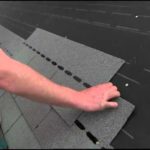 Asphalt and fiberglass-asphalt shingle are the most common roofing materials you will see in this area. They are built with a dark underside covered with granules of asphalt or asphalt-fiberglass particles. Roof shingles overlap one another, so there is a lot of protection. Over time, the colored granules wash off.
Asphalt and fiberglass-asphalt shingle are the most common roofing materials you will see in this area. They are built with a dark underside covered with granules of asphalt or asphalt-fiberglass particles. Roof shingles overlap one another, so there is a lot of protection. Over time, the colored granules wash off.
The first thing you will notice as a roof ages is that the edges of each rectangle seems darker and more visible, from a distance. Up close, you’d see that there is more erosion of the granules closer to the edges which creates the darker appearance.
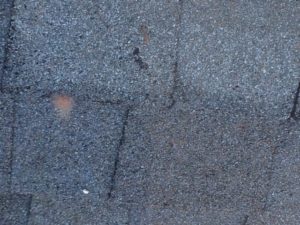 When more erosion takes place, the roof develops dark spots where a section of granules has eroded through to the dark under-layers.
When more erosion takes place, the roof develops dark spots where a section of granules has eroded through to the dark under-layers.
Especially in fiberglass — but in both kinds of shingle — the next thing that could happen is vertical cracks through the shingles. It is caused by uneven expanding and contracting of the tile. When this kind of erosion and cracking occurs, water has more of a chance to get deeper into the shingle. Come winter, water seeps in, freezes, then expands the crack or worn spot even more. It speeds up the death of the roof. The water seeps deeper in with every rain.
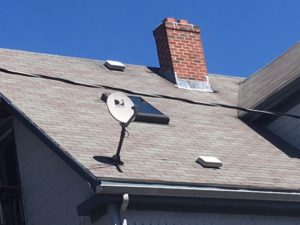 As the lowest edge of each tile ages more, you start to see a bumpiness, when tiles pop up or puff out. The one to the right is popping up. Inspectors call it “fish mouth.” This roof is only starting to age. It is ten years old. Look carefully, you will see a dark line at the bottom of a shingle between the TV dish and the white vent.
As the lowest edge of each tile ages more, you start to see a bumpiness, when tiles pop up or puff out. The one to the right is popping up. Inspectors call it “fish mouth.” This roof is only starting to age. It is ten years old. Look carefully, you will see a dark line at the bottom of a shingle between the TV dish and the white vent.
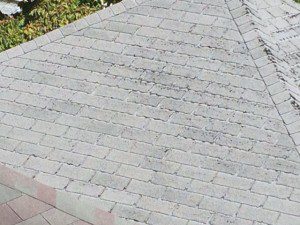 When the tiles get puffy, the roof is near its end. Like the one to the right. But, it’s not dead yet. Remember there are two layers of shingle on the roof (and maybe another two underneath it.) So, it probably isn’t leaking yet.
When the tiles get puffy, the roof is near its end. Like the one to the right. But, it’s not dead yet. Remember there are two layers of shingle on the roof (and maybe another two underneath it.) So, it probably isn’t leaking yet.
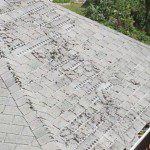 On the left, this is another side of the same roof. It’s in worse shape and some of the shingles have fallen off. Even then, it is possible the roof is not leaking yet.
On the left, this is another side of the same roof. It’s in worse shape and some of the shingles have fallen off. Even then, it is possible the roof is not leaking yet.
Like people, roof shingles age. Some age more gracefully than others. Most shingles are designed to last twenty years. There are some fifteen year and thirty year shingles for sale, too. A well ventilated roof will last longer because the temperature of the outside surface is similar to the temperature of the underside; this makes the tile stretch more evenly when it expands and contracts in the heat and cold.
A roof that is not in direct sunlight will fare better. Roof shingles are pretty resistant to small falling branches, but sometimes they will get damaged by heavy wood falling on them. Wind can blow a roof right off, under the right (or wrong!) conditions. There are some special tiles designed for high-wind conditions. We see them sometimes in hilly neighborhoods.
So what does a totally dead, leaking roof look like? Here is a sad example. This house had two roofs, one on top of the other. Both have failed and have exposed the wood underneath. It took 30 years for this to happen.
As a home owner, expect to replace a roof every twenty years. As a house hunter, use this guide to help you estimate if your roof is closer to new, middle aged, or old.




Is it possible to get rid of the black mold resulting from a leaking roof?
Thank you.
Hi Marjorie,
Is the mold on porous surfaces, like wood or plaster or wallboard? If so, the leak needs to be repaired first. A professional mold remediator can then clean moldy surfaces and treat it to prevent regrowth, depending on the extent of the mold growth on the porous surfaces. If the mold has had too much time to get deeply into wood, plaster, or wallboard, then those materials may need replacement. It is beyond what I know to tell you exactly where the line is between clean it and replace it. That needs an expert who understands mold.